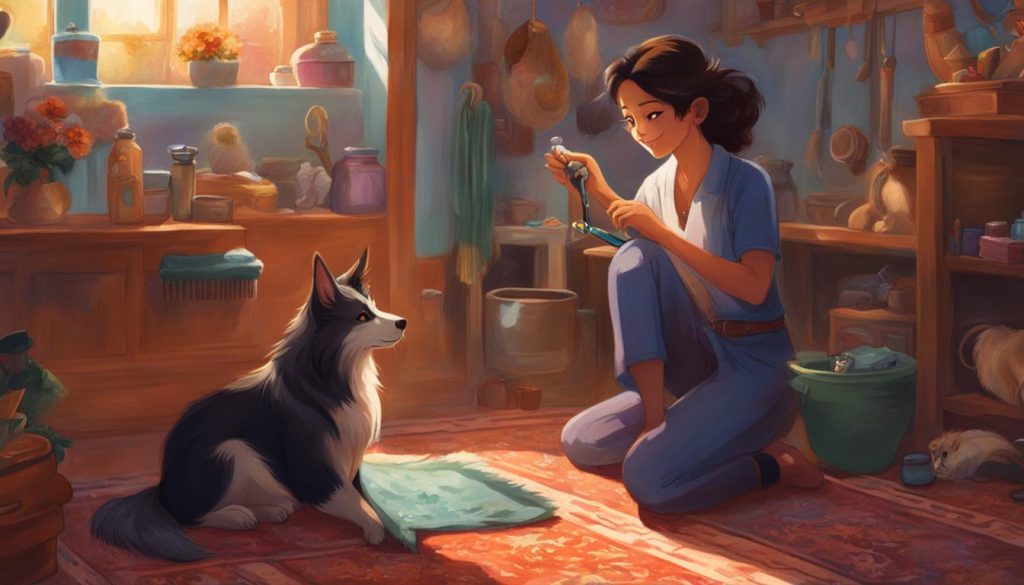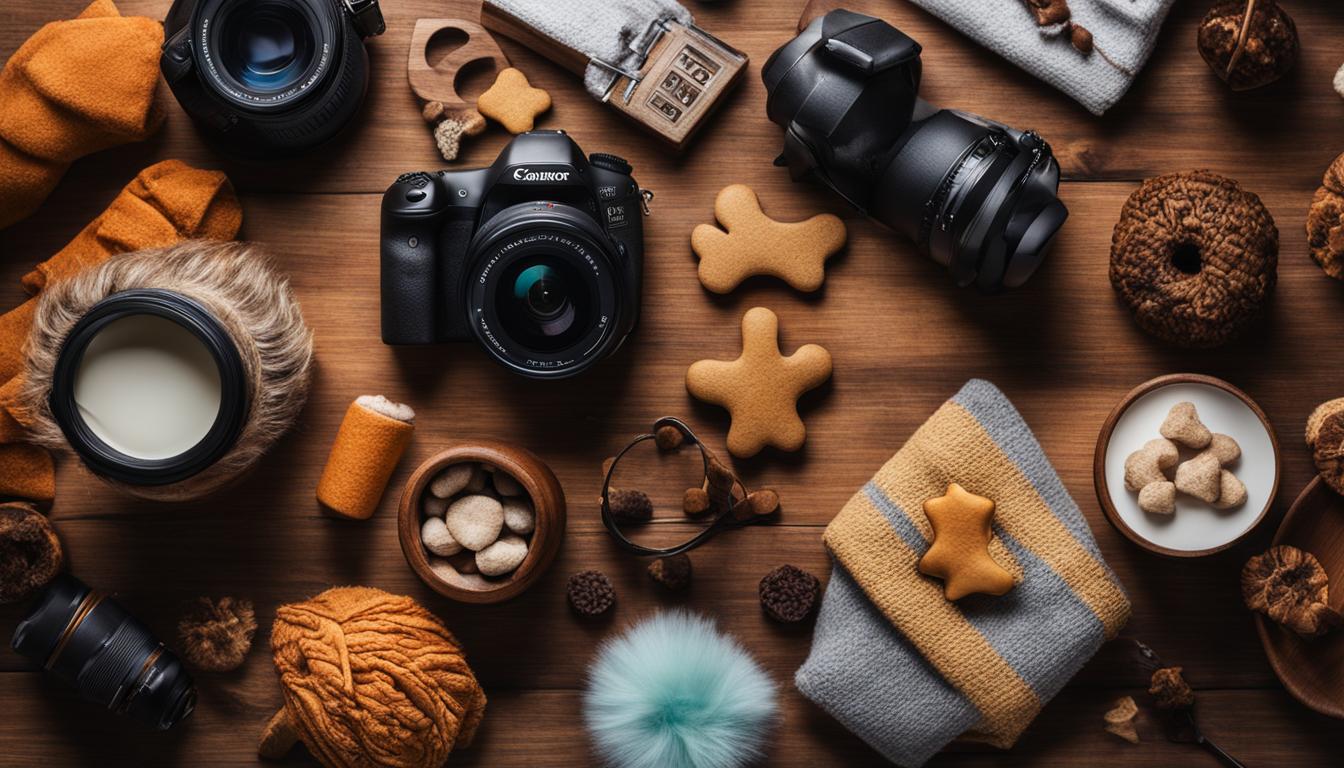Are you struggling to capture the perfect shots of your furry friends? Look no further! With our essential pet photography checklist, you’ll be able to take amazing pictures of your pets like a pro. Whether you’re a professional photographer or simply looking to take adorable and memorable pet photos, our checklist includes everything you need to know to make your pet photography a success.
Key Takeaways:
- Our essential pet photography checklist will ensure you don’t miss any important details.
- Choosing the right equipment for pet photography is crucial.
- Creating the perfect setting and preparing your pet for the photoshoot is necessary for perfect shots.
- Lighting and composition play significant roles in pet photography.
- Engaging with your pet and capturing authentic moments are secrets to taking amazing pet photos.
Choosing the Right Equipment
Photographing your pets requires the right equipment, so before you start, it’s important to ensure you have the right gear. The essential equipment you need for pet photography includes cameras, lenses, and accessories.
When it comes to cameras, there’s a wide range to choose from, but we recommend using a DSLR or mirrorless camera. Both offer greater flexibility and image quality compared to compact cameras or smartphones. Consider investing in a camera with fast autofocus and continuous shooting mode to capture your pet’s movements and actions.
Choosing the right lens depends on your pet’s size and the type of shots you want to take. A 50mm prime lens is ideal for portraits and close-ups, while a wide-angle lens is perfect for capturing the environment and scenery around your pet. Don’t forget to invest in a good quality lens filter to protect your lens from scratches and dust.
Accessories such as a tripod, external flash, or remote shutter release can also be handy for pet photography. A tripod can help stabilize your camera for low light shooting, while an external flash can provide better lighting options and avoid harsh shadows. A remote shutter release can also come in handy to avoid camera shake or to take pictures from a distance.
Tip: When choosing equipment, consider your budget and specific needs. You don’t need to break the bank to get good quality gear. Look for deals or consider renting equipment before investing in your own.
Note that photography gear goes beyond the camera and lenses. As you get more serious with pet photography, you may find yourself looking for additional equipment such as portable reflectors, diffusers, or scrims. You may also need a waterproof cover or protective gear for outdoor photo shoots.
Setting the Scene and Preparing Your Pet
Setting the scene and preparing your pet for the photoshoot are essential steps to capture the perfect shot. Start by selecting the right location for the shoot. Consider a place where your pet feels comfortable and natural, either indoors or outdoors, with good lighting and minimal distractions in the background.
Once you’ve found the perfect spot, it’s time to prepare your pet. Make sure they feel comfortable and calm, offer treats, and give them time to get familiar with the surroundings.

Using props can add charm to your pictures and make the photoshoot more enjoyable for your pet. Choose simple and safe props that reflect your pet’s personality and style. Toys, blankets, favorite treats, or costumes are good starting points.
Remember to take a few test shots before starting the actual photoshoot. This will help adjust the lighting, camera settings, and prop placement. By setting the scene and preparing your pet, you’ll be able to create beautiful, engaging, and unique pet photographs.
Mastering Lighting and Composition
Great lighting and composition are key to creating stunning pet photographs. In this section, we’ll explore some different lighting techniques to help you best showcase your furry friend’s unique features.
- Utilize Natural Light: Taking advantage of natural light will help capture your pet’s true colors. Early morning and late afternoon light provide softer, warmer tones that can create a beautiful atmosphere for your pet’s portrait.
- Use Flash Carefully: If natural light is not sufficient, artificial lighting can be utilized. However, direct flash can have an unnatural effect, creating harsh shadows and reflections. Try diffusing the light through a white umbrella or bouncing it off the ceiling to create a natural and soft effect.
- Consider Your Background: Your pet should be the focal point of the photograph. Choose a simple background that doesn’t distract from your furry friend. Alternatively, use a blurred or bokeh background to create a beautiful and soft effect.
Composition is also crucial when taking great pet photos. Here are some principles to keep in mind:
- Rule of Thirds: Placing your pet off-center in the frame creates a visually interesting image.
- Framing: Use natural elements like trees or door frames to frame your pet and draw attention to them.
- Angles: Experiment with different angles to showcase your pet’s unique personality. Consider getting down at their level or shooting from above to create distinct and interesting photos.
By mastering lighting and composition, you’ll be able to capture stunning pet photos that showcase your furry friend’s unique features. Check out the example below to see how the right lighting and composition can result in a truly beautiful photograph.
Engaging with Your Pet and Capturing Authentic Moments
There’s nothing quite like capturing authentic moments during a pet photoshoot. Engaging with your furry friend is the key to achieving effortless and genuine photos that showcase your pet’s personality. Here are some tips on how to create these memorable moments:
- Have Patience: Sometimes, pets can be unpredictable and may not cooperate right away. Be patient and let your pet get comfortable in the surroundings. Take as much time as needed to create a stress-free environment.
- Get on Your Pet’s Level: Photographs taken at eye-level of your pet produce intimate and eye-catching photos. Crouch down, sit on the ground, or lie flat to capture unique angles and perspectives of your pet.
- Use Treats and Toys: Entice your furry friend with their favorite toys or treats to get their attention and make them feel comfortable. This will help you capture their natural behavior.
- Play with Your Pet: Engage in a little playtime with your pet to encourage natural behavior and movement. It will help you capture spontaneous and lively moments.
- Be Mindful of Your Pet’s Behavior: Pets have distinct personalities and unique ways of moving and expressing themselves. Observe how your pet moves and capture their natural behavior.
By following these tips and engaging with your pet, you’ll be able to capture authentic moments and create memories that will last a lifetime. Don’t forget to have fun and enjoy the bonding experience with your furry friend!
Conclusion
Photographing pets can be a fun and rewarding experience that creates lasting memories. By following the essential pet photography checklist and tips provided in this article, you can capture stunning photos of your furry friends. Remember to choose the right equipment, set the scene, master lighting and composition, engage with your pet, and be patient. The process may take time, but the end results will be worth it.
With these techniques, you can capture your pet’s unique personality and create one-of-a-kind images that you’ll cherish forever. So grab your camera, round up your pets, and start snapping away. Happy pet photography!






